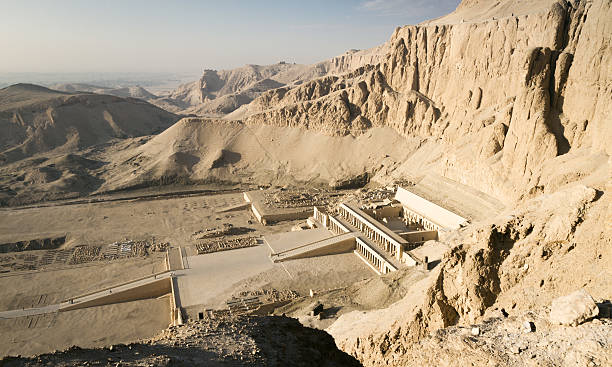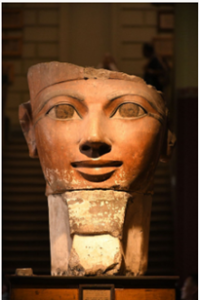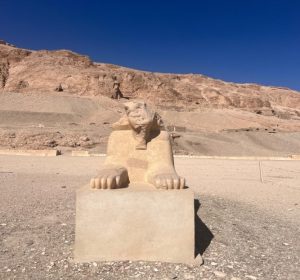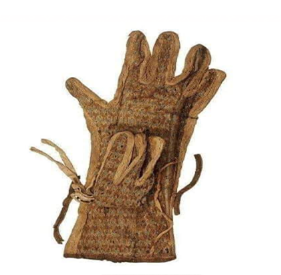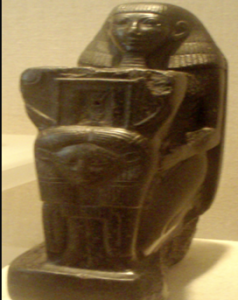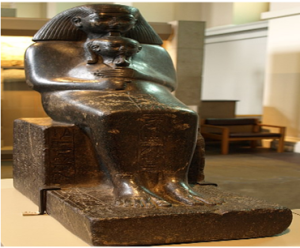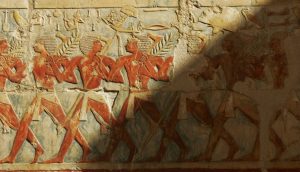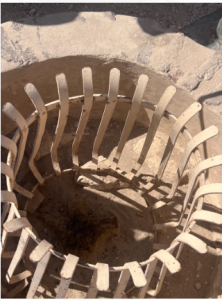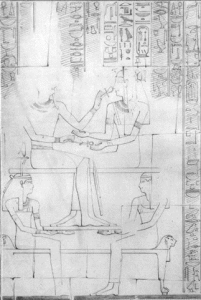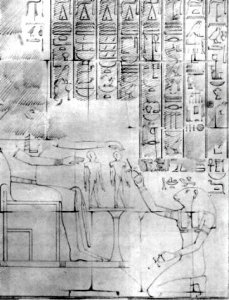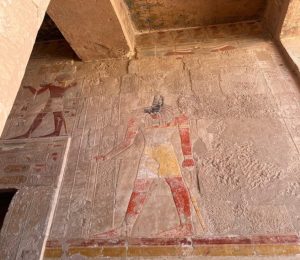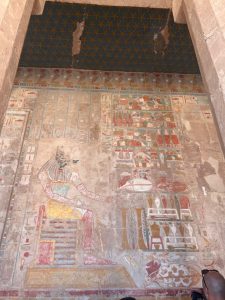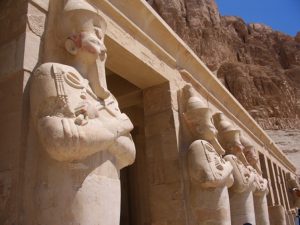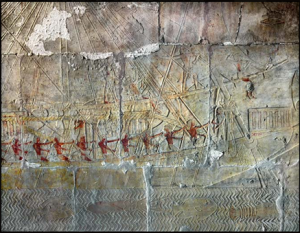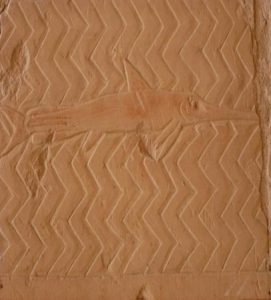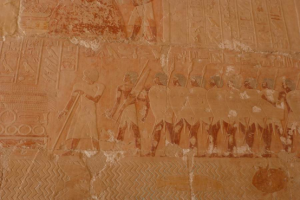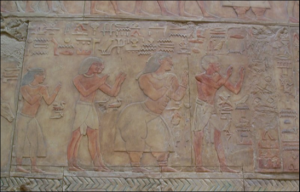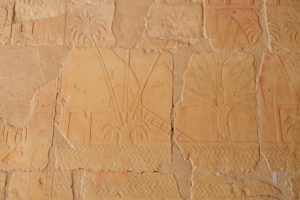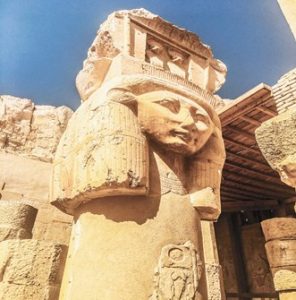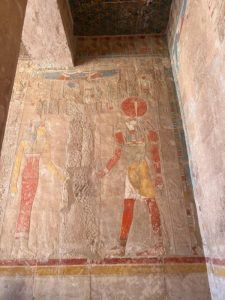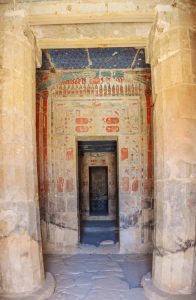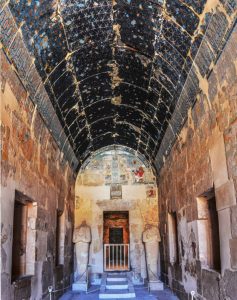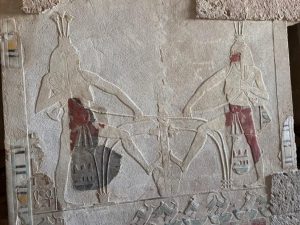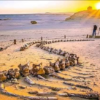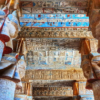Hatshepsut’s Temple (Deir el-Bahri)
Hatshepsut ruled Egypt from 1505-1483 BC. Queen Hatshepsut is considered the greatest queen of Egypt until Queen Cleopatra. After the death of King Thutmose I, the founder of the Egyptian Empire, his son King Thutmose II ascended the throne. He married his sister, Queen Hatshepsut, a woman of strong character. Thutmose II ruled for 4 years, but the reins of power were in the hands of his wife Hatshepsut, a woman of strong character. Hatshepsut did not bear him a son, so he married a second time and she bore him Thutmose III. Upon the death of Thutmose II, his son King Thutmose III was supposed to ascend the throne. But due to his young age (about 8 years), Queen Hatshepsut married him to her daughter and seized the throne herself. To legitimize her sitting on the throne, the priests invented a divine birth story for her. It tells that the god Amun sneaked into her mother’s bedchamber at night and gave her the key of life, meaning he gave her the breath of life for her daughter Hatshepsut. Thus, after her birth, she became the daughter of the god Amun, and by this, she had the right to sit on the throne. She ordered this story to be inscribed on the walls of her mortuary temple in western Thebes. And to thank the god Amun, she built a beautiful edifice in the Karnak Temple and erected two obelisks of red granite, one of which still remains in the temple, while the other was broken during an earthquake and its head remains, which was erected in 2023 AD next to the sacred lake in the Karnak Temple. She also established this immortal and distinctive temple on the west bank as a mortuary temple for her and to receive the god Amun on the Valley Feast (the feast of the god Amun’s visit to the dead on the west bank). Queen Hatshepsut ruled Egypt dressed as a man, so she depicted herself with a beard. Queen Hatshepsut is considered the first to use a glove, to hide a defect in her fingers. The era of Queen Hatshepsut is considered one of the most prosperous periods in Egyptian history, especially in terms of trade with neighboring countries. During the queen’s reign, some Nubians raided the property of the Egyptian state at the first cataract, and some disturbances occurred, so she sent a military campaign to suppress this rebellion. She also sent a naval expedition to the land of Punt in Africa via the Red Sea, loaded with all the goods of Egypt, such as wine, meat, fruits, as well as jewelry and weapons like daggers, linen clothes, and papyrus. This expedition brought products from Africa, the most important of which were incense trees that she planted in front of her temple on the west bank in Luxor and also in front of the Karnak Temple. She also brought henna, ivory, frankincense, ebony, and many other goods from Africa.
Senenmut
Senenmut The most famous character in the reign of Queen Hatshepsut is her vizier Senenmut, who took care of her daughter Nefrure who died during her mother’s reign and supervised the construction of her temple at Deir el-Bahri. He built this temple in a terraced manner, similar to the neighboring temple that was built from the Middle Kingdom era of Mentuhotep II. He also connected the Deir el-Bahri temple with a secret passage to the Valley of the Kings, where Hatshepsut built her tomb there in the Valley of the Kings
A statue of Queen Hatshepsut in the Egyptian Museum was found in her temple in Deir el-Bahari
A statue of Queen Hatshepsut in the form of a sphinx was found in her temple at Deir el-Bahri
Image of the gloves
Statue of Senenmut from the Metropolitan Museum
Senenmut embraces Neferure from the British Museum
Naming the temple
The temple was built in the eighth year of Queen Hatshepsut’s reign. Good quality limestone was used in its construction instead of yellow sandstone. In the reign of Hatshepsut, it was called the Holy of Holies of Amun. It was shortened in the Ramesside era and called the sacred spot. After the spread of Christianity in the 7th century AD, it was called Deir el-Bahri, after the Copts of Egypt made the temple their monastery.
Description of The Temple
The architect Senenmut took the design of the temple from a temple that was next to it from the Middle Kingdom, from the era of Mentuhotep II. The most important feature of this design, which was not repeated in Egyptian civilization, was that it was in the form of levels on top of each other. The temple has three levels: The first level represents scenes of bird hunting on the right side of the interior but is damaged. On the left, there are scenes of transporting the obelisks from Aswan to Karnak. The second level represents scenes of Hatshepsut’s journey to the land of Punt and scenes of the divine birth. There are also two chambers for the goddesses Hathor and Anubis. The third level includes the Holy of Holies. In front of the temple, there are statues in the form of sphinxes of Queen Hatshepsut. The queen also ordered the planting of incense trees that were brought from the land of Punt in front of the temple. The place of these trees still exists today.
Scenes from the first floor
A scene representing the celebration of soldiers during the transfer of two obelisks from Aswan
A scene representing the parade of soldiers and the celebration of the transfer of obelisks
The place of planting incense trees in front of the temple of Hatshepsut
Second level
It consists of two halves, one right and one north. To the right of the interior, we find the chamber of Anubis, the views of the divine birth and the Osirian columns. The Divine Birth It was customary for the ancient Egyptian kings to belong to the gods. After the death of King Thutmose II, the husband of Queen Hatshepsut, and due to the young age of his son Thutmose III, Hatshepsut aspired to rule, so the priests invented a divine birth story for her to reach the throne. The queen depicted this birth on the right side of the second level in her temple. We see the god Amun-Ra entering the bedroom of Hatshepsut’s mother and giving her the key of life, proof of giving her the breath of life for the child. We also see another scene of the god Amun ordering the god Khnum to shape the child and her spiritual double on the potter’s wheel. Then we see the rest of the scenes of the divine birth until the birth of Hatshepsut and her taking over the rule of Egypt as the daughter of the god Amun.
Amon gives the key to life to Hatshepsut’s mother (gives her the breath of life)
god Khnum shapes Hatshepsut and her spiritual double on the potter’s wheel
The Chamber of Anubis
The god Anubis is the guardian god of royal tombs and is essentially the illegitimate son of Osiris and Nephthys. He was depicted in the form of a jackal. He helped mummify Osiris, and had a special sanctity among the ancient Egyptians. Therefore, a chamber for Anubis was found in this temple. In this chamber, we see many scenes of Queen Hatshepsut with many Egyptian gods, the most important of which are Anubis and Amun-Ra.
Picture for God Anubis
Offerings for God Anubis
God Amun in The Chamber of Anubis
Osirian columns of the Temple of Hatshepsut on the second floor
To the north of the interior, we see a hall with views of Hatshepsut’s expedition to the country of Punt and the chamber of the goddess Hathor
Hatshepsut’s Expedition to Punt
In the ninth year of Hatshepsut’s reign (1496 BC), Queen Hatshepsut sent a trade expedition to the land of Punt to bring her incense trees, gold, ebony, henna, and all the good things from the land of Africa. The expedition consisted of 5 ships with 210 men led by Panehesy. The journey sailed via the Nile to the Senusret Canal located in Fayoum, which connects Fayoum to the Red Sea, then sailed from a port on the Red Sea until it reached the land of Punt (present-day Somalia). The artist depicted the fish of the Red Sea, which indicates his skill and accuracy in depicting fish and the difference between them and the fish of the Nile. We see scenes of the arrival of the expedition and its reception by the ruler of Punt, his wife, and his children. We see the largeness of his wife, and the ancient Egyptian loved a slim woman, so the artist made a funny joke and wrote behind the wife of the ruler of Punt a funny sentence above the donkey she was riding: “This is the poor donkey that the wife is riding.” The most important thing in the scene is the houses of the inhabitants of Punt, as they were huts on top of trees. This indicates the cultural difference between them and Egypt, which made the artist draw them, and they were climbing to them through wooden ladders. Then we see scenes of Panehesy receiving the ruler of Punt, his wife, and his children in his tent, preparing a dinner for them (as it is known today as a diplomatic dinner) consisting of wine, meat, fruits, and bread. We see scenes in the upper rows of incense trees being transported with their roots in baskets filled with mud by soldiers. And we notice the men walking on scaffolds carrying different trees into the ships. Then there is a scene representing three ships with their sails spread ready to sail to Egypt. This is followed by scenes representing Queen Hatshepsut (shaven-headed) accompanied by her Alka (spiritual double) offering the goods of Punt to the god Amun, including incense trees, various animals such as leopards, leopard skins, giraffes, and cattle, as well as bows and gold. There are also scenes of measuring incense, and Thoth is recording, and beside this, we see Thutmose III burning incense in front of the boat of Amun carried by the priests. At the end of the western wall, there is a shaven-headed image of Queen Hatshepsut in front of the god Amun. There is a scene on the northern wall of the queen sitting on her throne addressing three of the senior statesmen, and the scene is completely damaged. But there is a text in which Hatshepsut addresses Amun, saying: “I have immortalized Punt within God’s house, and I have planted the trees of the land of the god beside his temple in his garden according to his command.”
Ships of the Punt Expedition
Scenes of the fish that live in the Red Sea
An image showing the reception of the ruler of Punt for Queen Hatshepsut’s trade expeditions in the land of Punt.
Panehesy meeting the ruler of Punt
The ruler of Punt, his wife, and behind them their sons and daughter, receiving Queen Hatshepsut’s expedition
Scenes of the houses of the people of Punt in the form of huts that they climb up to using ladders
An image showing the incense trees that were brought from the land of Punt to Egypt
An image of the trees that were brought from the land of Punt and were planted in the courtyard of the Deir el-Bahri temple
Hathor’s Chamber
Beside the scenes of the Punt expedition, to the south of it, we find the chamber of the goddess Hathor. It consists of two parts, the first is built and the rest is carved into the mountain. It is in the form of two halls, the first consisting of 12 columns with the face of Hathor on them. One of the most beautiful scenes is the scene of Hathor inside a sarcophagus while she is breastfeeding Queen Hatshepsut. The second hall has scenes of a procession of boats carrying statues of Hathor across the Nile.
The columns of Hathor’s chamber ( a column carrying the face of the goddess Hathor)
Hathor Breastfeeds Queen Hatshepsut
The Third floor
It consists of two rows of Osirian columns of Queen Hatshepsut, but they are damaged. Then there is a pink granite entrance leading to the Holy of Holies carved into the rock. There is a group of chambers, the most important of which is for Ra-Hor Akhty and Amun. There are also chambers for Hatshepsut and her father Thutmose I, where they offer sacrifices.
The Holy of Holies
All the scenes inside the Holy of Holies represent the relationship between Hatshepsut and Thutmose III and the Egyptian gods. In the Ptolemaic era, a chamber was added inside the Holy of Holies dedicated to the worship of Imhotep (the engineer of King Djoser from the Old Kingdom) and Amenhotep son of Hapu (the engineer of the era of King Amenhotep III who oversaw the construction of the Karnak Temple). This is because they were deified in the Ptolemaic era.

